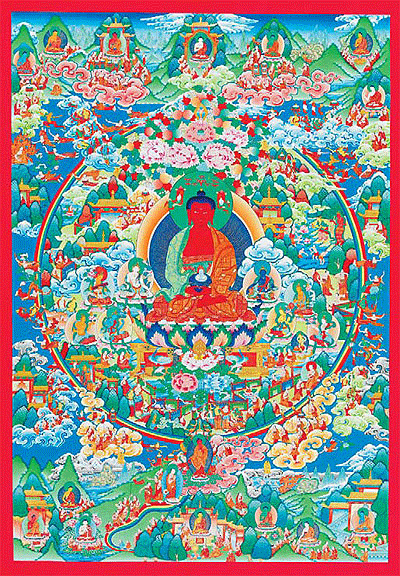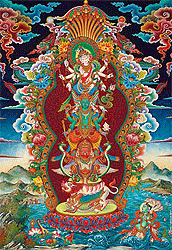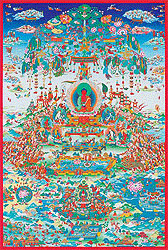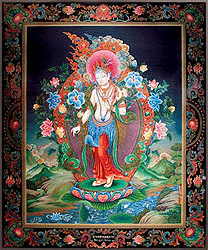
If there is one thing permanent about art, it is the fact that the consumption of repetitive modes of expression, like all other consumption, inevitably leads to aesthetic fatigue.
A city overwhelmed with conceptually bold contemporary art galleries such as Bangkok deserves a break from the modern/postmodern chic and might consider taking refuge in the now ecclesiastical space of Serindia Gallery, which is presently housing various meticulous manifestations of Buddhist and Hindu deities.
”Avalokiteshvara”, Serindia’s latest soul-drenching show, features selections of Buddhist paintings from Nepal by Robert Beer, an artist, collector and authority on Tibetan Buddhist symbolism. Beer’s drawings and paintings appear in countless books; his works, The Encyclopedia of Tibetan Symbols and Motifs and The Handbook of Tibetan Buddhist Symbols, both published by Serindia Publications, have become standard reference sources on the subject.
Though embodying various interpretations of compassion, Avalokiteshvara is by no means an easy show; indeed, compassion must come with devotion. A quick and superficial tour might not only defeat the original purpose of tantric transformation in the viewer, but may also produce the false impression that every work in the exhibition is of quite the same nature and characteristics.
 Reading the provided captions, thus promises to equip the viewer with necessary power to decipher each symbolic presence, gesture and composition, facilitating the intended effect of tantric transformations. The magnificent Thai translation of these commentaries, which makes the exhibition much more accessible to a local audience, is provided by Arthid Sheravanichkul.
Reading the provided captions, thus promises to equip the viewer with necessary power to decipher each symbolic presence, gesture and composition, facilitating the intended effect of tantric transformations. The magnificent Thai translation of these commentaries, which makes the exhibition much more accessible to a local audience, is provided by Arthid Sheravanichkul.
Given the seamless blend between Tibetan and Indian religious traditions in modern Nepal due to the dynamic historical migration in the region, it is easy for some viewers to be confused why Buddhist and Hindu deities are juxtaposed not only in the same show, but also on the same canvases.
The exhibition, indeed, not only presents Buddhist deities such as Sahasrabhuja Avalokiteshvara or Amitabha in Sukhavati, but also popular Hindu gods such as Vishnu, Brahma and Ganesh. Hari Hari Hari Vahana Lokeshvara (2008) by Ram Prakash Shrestha, which, in the Newar tradition, positions the Buddhist Lokeshvara as the supreme ”Lord of the World” above the Hindu Vishnu, the all-pervading protector of the universe, who, in turn, is above the animals of the three realms _ Garuda the lord of the skies, the lion the lord of the Earth and Takshaka the lord of the underworld _ which is one of the best examples of how such religious and cultural assimilation works in Nepal.
”Buddhist and Hindu gods have become so intermixed that they frequently face each other across the same shrines or temple courtyards. To the Newars, the gods are gods, so they paint Hindu and Buddhist deities with the same devotion, and will equally petition their help when divine inter vention is called for,” explained Beer of the Nepalese culture of worship.
Apart from commentary, the show also provides an orientation guide for how to differentiate and appreciate the different styles featured. Despite ”Nepal” being the indication of origin, Avalokiteshvara does not promise a monolithic representation of the Republic of Nepal: the works in the exhibition are products of religious devotion by two different ethnic groups of the Nepalese artists: the Newars and the Tamangs. Though the former are known as the original inhabitants of the Kathmandu Valley, migrating from India, and the latter as horse warriors _ ta means horse, mang means soldier _ both are devoted practitioners of Tibetan Buddhism and its art.
 However, while contemporary Tamang artists choose to adhere to the traditional Tibetan style known for its two-dimensional stylised simplicity and serenity, be it the Indo-Tibetan or Sino-Tibetan style as exemplified by Sunlal Ratna Tamang’s 2006 and 2009 versions of Amitabha in Sukhavati, in which the show takes pride, contemporary Newar devotional artisans have demonstrated a clear dynamic development in the increase of depth, a more photogenic three-dimensional innovation of complexity, and a flight towards realism with more emotional response. This stylistic breakthrough, of course, shows how artists of the two clans view the function of their art differently. The Tamangs take their creative offerings as meditation support, whereas the Newars regard their crafts as devotional icons.
However, while contemporary Tamang artists choose to adhere to the traditional Tibetan style known for its two-dimensional stylised simplicity and serenity, be it the Indo-Tibetan or Sino-Tibetan style as exemplified by Sunlal Ratna Tamang’s 2006 and 2009 versions of Amitabha in Sukhavati, in which the show takes pride, contemporary Newar devotional artisans have demonstrated a clear dynamic development in the increase of depth, a more photogenic three-dimensional innovation of complexity, and a flight towards realism with more emotional response. This stylistic breakthrough, of course, shows how artists of the two clans view the function of their art differently. The Tamangs take their creative offerings as meditation support, whereas the Newars regard their crafts as devotional icons.
It was Anandamuni Sakya (1903 to 1944) who was not only responsible for the vibrant renaissance of the indigenous Newar art tradition _ after the increasing amount of absorption of Hindu cultural influence over the last few centuries in the region, it became stagnant and deserted _ but also for revolutionising it. Anandamuni went to Tibet at 16 years of age and began to paint Western-style portraits of aristocrats in Tibet and was recognised as a divine artist by the 13th Dalai Lama. When the ”divine artist” was back in Nepal he began painting deities in realistic, photographic forms. In many ways, Anandamuni could be compared to the Italian painter Giuseppe Castiglione (Lang Shining) who, in the 18th-century Chinese Qing dynasty court, introduced Western portraiture and realism to the otherwise two-dimensional Chinese painting style. One might also think of artist Khrua In Khong who first introduced the Western three-dimensional style to the Siamese court in the reign of King Rama IV. In retrospect, Anandamuni revolutionised the static, two-dimensional Indian-miniature style of Newar art. Anandamuni’s innovative path was further paved by his son Siddhimuni Sakya (1933 to 2001). Experiencing his fathers death at 11 years of age, Siddhimuni set out to be an even better painter than his father and began to copy many of his father’s works. In time, he developed his own unique style which incorporated a whole pantheon of symbolic motifs; he is praised for his attention to detail, originality and the meticulous painting techniques.
Apart from his three-dimensional features including more realistic backgrounds which entail depth and better emotional response, useful tools to identify this influence under the Sakya lineage include the identification of paintings with frames of intricate motifs. Padmapani Lokeshvara by Sundar Sinkhwal (2007), for instance, best represents this trend of following Western-influenced realism in the Newar art; a path first set out on by the Sakya father and son.
 A relevant anecdote of how Anadamuni received a book on the renowned Italian renaissance painter Sandro Botticelli helps shed light on the affinity between the half-shelled Venus composition and that of Sinkhwal’s Padmapani Lokeshvara.
A relevant anecdote of how Anadamuni received a book on the renowned Italian renaissance painter Sandro Botticelli helps shed light on the affinity between the half-shelled Venus composition and that of Sinkhwal’s Padmapani Lokeshvara.
Among others, a reservation on Beer’s selections and presentation here is that these religious paintings are all new, when pitched against the usual expectation of religious iconographies to be of great antiquity in order to be sacred and worthwhile. To this, Beer said, ”I see the work of the artist not through its age, or its material value, or its rarity. My fascination in this art is that it is still a living tradition where the artists work with devotion, devoting from the heart, putting their understanding to the religion and iconographic images on to the painting. There is far more meaning to be derived from studying this art form than from studying contemporary/conceptual art.”
And by devotion, Beer means perseverance and courage. ”Some of the more complex compositions I have collected took more than a year to finish, while most of Siddhimuni’s masterpieces took over three years to complete. Siddhimunis son recently finished a painting of Vishvarupa Lokeshvara that took six years to paint. This is devotion.”
Source : http://www.bangkokpost.com




